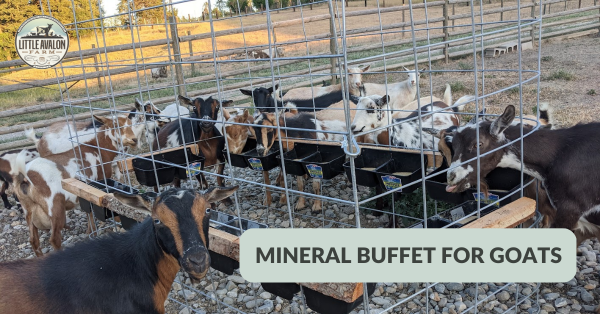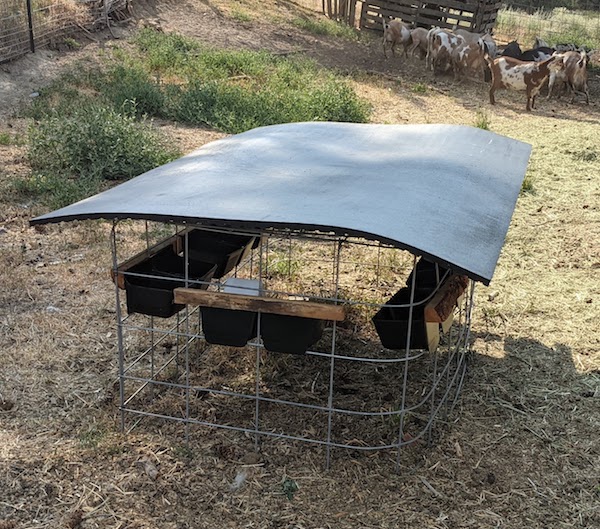Mineral buffet for our goats all started because of 16 dead kids. For eight years, we had raised goats on a dry lot with free choice alfalfa, locally sourced loose minerals and no live born kid losses. Zero. Then we had the wonderful fortune of buying our own farm 30 miles away on 9 lush acres with a year-round creek and everything we dreamed of.
Like a good goat owner, I religiously gave copper bolus and Bo-Se shots, because we're in a "deficient" area. It worked well for us at our old house and since we were still mapping deficient, I didn't give it a second thought. Giving copper and Bo-Se every 6 months is just something you do. Then our first kidding season at the new place began.
Being slow to notice patterns and finding ways to explain away every death, it took me two years and 16 dead kids to realize there was something going on. "Oh, that one must have been headbutted." "That one crawled in that hole and must have been stuck." Etc. etc. I really was dense about it, but life was a bit crazy then. I talked with local and state vets and the only thing we could come up with was mineral issues. We had kids born seemingly healthy, then fading away over 3-4 days. I intended to send in the next one for a necropsy but we didn't have another loss, a fact I'm simultaneously grateful for but also a little disappointed that we wouldn't be able to get a definitive answer.
Instead, we sent liver samples from two does on May 2018 and March 2020. Both of these does had never received supplemental copper or selenium, yet each displayed high levels of one or the other.
Here's Jubilee, a yearling first freshener whose only mineral access was a goat formulated loose mineral and whatever she took in on forage.
 And Jeaudee, a maiden yearling doe. This doe was fed New Country Organics Goat Mineral her whole life and never received supplemental minerals outside that.
And Jeaudee, a maiden yearling doe. This doe was fed New Country Organics Goat Mineral her whole life and never received supplemental minerals outside that.
Carpal Hyperextension and Mineral Buffet for Goats
While we were dealing with that issue, a buck I'd flown in from out of state started limping on one front leg. He'd pick it up and extend it in front of him on rising, then limp for awhile before seeming to normalize the rest of the time he was on his feet. At the time, I thought he'd injured himself but then I read Pholia's article on The Limping Goat and realized I had something else going on.
Though I bred him to a number of does, I've never heard of any of his offspring developing this trait. An unrelated doe, however, began displaying the same symptoms and I knew I needed to figure something out.
Based on Pholia's information, mineral buffet for goats seemed to be the best choice. The carpal hyperextension combined with our previous mineral eccentricities had me convinced that letting my goats self correct imbalances was the way to go.
Drawbacks to Mineral Buffet for Goats
It took me several years after that to be able to get started with mineral buffet because of its main drawback: that it only comes in 25-pound bags from the manufacturer. I finally decided to take the plunge and bought in a whole pallet with a couple friends. With shipping alone costing several hundred dollars though, I began to dream on a way to make this option accessible to everyone.
The second major hurdle we've run into and heard from other producers is the size required for the mineral feeders. We use the 2-hole black mineral feeders but with 20 different minerals, this creates a substantial footprint. It isn't feasible to easily add one to every pasture either, so you're left having to decide which animals will go without and for how long. I want to add though that we used mineral buffet for our rabbit colony and it worked perfectly in little 4-ounce jars tied to the fence. Smaller containers can work too, depending on your setup. Edit for 2022, I played with some different small setups that can work for small herds - take a look here.
We put together this feeder in a couple of hours from a cattle panel, 10 2-hole mineral feeders and an $80 stall mat for a total cost of about $150. It's not light--especially the stall mat--or easily portable, but it works really well for hornless goats. Our Nigerian Dwarf bucks, with their larger heads, have a bit more of a squeeze to fit through but they make it work.
Gains We've Seen Using Mineral Buffet for Goats
There are a number of advantages others have seen when switching to mineral buffet for goats (here's a Facebook group dedicated to this system), but I want to talk specifically about our experiences and why I'm even more convinced that mineral buffet is the way to go.
First, though our goats are 100% herbal and have been in great shape for years, their coat condition this year was over the top luxurious and sleek. They built nice, thick coats for winter and just give such an impression of overall good health when you look at them.
Our kids per doe average stayed the same. We started feeding mineral buffet in July or so. It will be interesting to compare when they've been on it for a full year.
Hoof strength and condition seems to have improved. We generally trim hooves 1-2x/year and hoof strength seems notably better now, 8 months in.
Probably the biggest gain and one that is totally unexpected was in my carpal hyperextension doe's structure and pain management. Pholia specifically mentioned that once kids had access to this mineral buffet in utero, they no longer saw this issue in their herd. With that knowledge in mind, I wanted to give my doe one more kidding season in order to keep a doe out of her and watch this play out a few generations. Her last pregnancy had gone well, but she was clearly in pain toward the end of it. This year, much to my surprise, she fared late pregnancy as well as she normally does, with no outward signs of increased pain. In fact, she seemed stronger than ever.
Parallel to that, and perhaps a clue toward our quest for answers about carpal hyperextension in general, I noticed the silicon in the mineral feeder going down very quickly in the last month or two of gestation. Silicon is not something listed in the loose mineral blends I researched, so perhaps this essential structural mineral is playing a role in the presence or absence of hyperextension.
Added for 2023: I have a doe who has developed baldness on face and topline every winter for the past several years. I've tried numerous types of zinc with no results. I had high hopes the first winter on the buffet, but her baldness was worse than ever, which was discouraging but I figured it must not be a mineral issue after all. Then, to my utter delight, she didn't develop baldness in the winter of 2023. As I write this update mid-February, she still has a thick coat with no baldness. I'm so excited by this! It also tells me that mineral balance may not be corrected as quickly as we might have anticipated. Will subsequent generations continue to improve as their mothers finally achieve balance? I can't wait to see how we look a few years down the road.
Overall, I feel like the weight off my mind about whether or not they're getting balanced has been lifted. I'm enjoying watching the phases of their lives and how that impacts mineral consumption. For example, they hardly touched phosphorus until the very end of summer, when pasture quality was diminishing. Then they were heavy on it for a few weeks before moving onto zinc primarily, as if gearing up for a zinc deficient winter. It really has been an educational journey to see how much their consumption varies throughout the seasons and life stages.
I'm a firm believer that when we give the animals the choices they need and get ourselves out of the way, they have the instincts to seek and achieve optimal health. It's our belief in the far from settled "science" that can muddy the waters. (As an example of that, check out Kathy's resources put together after she experienced significant herd losses while using "goat formulated" products.)
How Much Mineral Buffet do Goats Consume?
When I first got started, I was frustrated that no one could really give me an answer on consumption. Now that I'm feeding it myself, I understand why. Every herd is so different that it is impossible to know what your animals will consume and how much until they get balanced. Based on my initial results, I estimated my own herd's annual consumption would come to about 10# per goat, which is about half what we used when feeding blended minerals. Now, I think I need to revise that number downward because we're only feeding out about one pound total per month. That will fluctuate of course, but we're using about one pound with 13 Nigerian Dwarf does, 6 hair breed sheep and 4 Nigerian Dwarf bucks. We may wind up planning on around 5# per goat per year, which makes this a much more affordable option since they don't consume anything they don't need.
Update: I have begun tracking exactly how much my animals are consuming and publish the results monthly here. Soon, we will have a much better answer for our own herd at least.
Where to Buy Mineral Buffet for Goats
After my own struggle and delay in being able to switch to mineral buffet, I reached out to the company, asking if they ever intended to carry smaller bags. They told me they did not, so I got the okay to repackage them myself, the start of a great working relationship. We now repackage in smaller sizes. To help make it easier to get started, I offer a starter kit at a discount over buying them individually. Then, once you know which minerals your herd is deficient in, you can reorder the larger quantities.
I feel passionately that mineral buffet is the correct way to approach minerals and I can't wait to see more herds being able to offer it to their goats. If you already do, I'd love to hear how it's changing your herd's lives! Join the conversation now in our Facebook group, The Holistic Goat.



